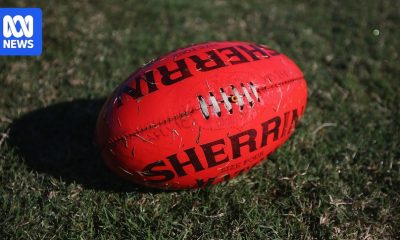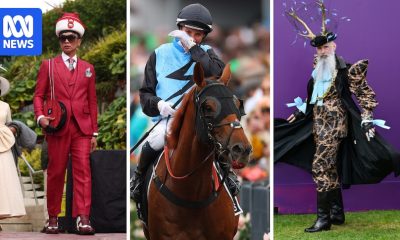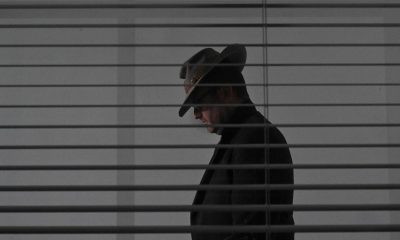Entertainment
Art auction sales the slowest in 22 years as coronavirus sidelines sellers and buyers – ABC News
Coronavirus hit the art world hard, with art auction sales the slowest in 22 years, but some sellers, such as art specialist Gene Sherman, are rolling the dice.

For 17 years, Gene Sherman has owned a striking Saddam Hussein portrait by the late Indigenous artist Gordon Bennett.
Despite Australia’s art auction market bottoming, she has decided now is the time to sell it and nine other paintings, with expectations of raising at least $420,000 from the sales.
“We’ve got 900 artworks,” she said.
“I’m 73. It’s not the moment to just sit back and not plan for the future.”
Gordon Bennett’s 2003 painting Camouflage #9.(Supplied: Deutscher and Hackett)
Ms Sherman was for many years one of Australia’s most influential art dealers.
She represented Bennett, along with other artists whose paintings she is now selling, including John Olsen, Tim Storrier and New Zealand artist Shane Cotton.
Five years ago, she began selling small groups of artworks from her collection at auction.
“It’s not a kneejerk reaction to what is happening around us. We don’t have to sell the work in financial terms, but what I do want to do is take those 900 and reduce them to about 300 key works,” she said.
Ms Sherman’s paintings will go under the hammer on July 15 in Melbourne, in what was supposed to mark a return to live auctions at one of Australia’s leading art auction houses, Deutscher and Hackett, after a shutdown.
The mixed catalogue of 129 mostly Indigenous and contemporary Australian artworks is expected to sell for between $5 million and $6.7 million.
The artworks were displayed in Sydney from July 1, then shown by appointment in Melbourne from July 8, ahead of what will now be an internet and phone auction.
Deutscher and Hackett usually hold their first Australian art auction for the year in April or May.
This year’s delay is indicative of the 25 per cent downturn in the number of art auctions held.
Coronavirus hits the art world, hard
Art dealers have told the ABC people are still buying art, even though galleries have been closed during the shutdowns.
They say sales have been conducted via gallery websites and phone, but there are no official figures to support this.
Art auction sales as reported by the Australian Art Sales Digest tell a different story.
So far this year, $25 million worth of art has been sold at auction, almost half the gross sales witnessed by the same date last year.
That’s resulted in the slowest trade in 22 years, not adjusted for inflation.
“I’ve been in the art business for 30 years and there’s been nothing like this,” auction house director Damian Hackett said.
“It’s not just the market. It’s how people are relating to each other and how we actually physically do things. Exhibiting and selling art is a human experience and with a lack of humans, it’s a bit tricky.”
Damian Hackett, executive director at fine art auction house Deutscher and Hackett, hasn’t seen anything like this in three decades in the industry.(ABC News: John Gunn)
In the art hotspots of London and New York, the situation is the same.
With restrictions still in place, Sotheby’s London recently staged a multi-city, multi-camera livestream auction where a Francis Bacon tryptic sold for a respectable $US85 million.
The difficulty in Australia has been convincing sellers to part with their artworks amid such uncertainty, Mr Hackett said.
Ms Sherman has such a vast collection she can afford to take some risks.
“You do not expect to be in an up cycle every minute, because it just doesn’t happen,” she said.
John Olsen’s 1991-92 artwork Nolan at Broome.(Supplied: Deutscher and Hackett)
Seller reluctance results in smaller catalogues
Australia’s first blue-chip auction after coronavirus restrictions was held in June by Smith and Singer, which recently rebranded after having traded for several years as Sotheby’s Australia.
Seller reticence resulted in a small catalogue of 59 artworks, which was down about 20 per cent compared to the company’s first sale for 2019.
The result, however, was solid 76 per cent of the lots sold, for a total of $6.6 million.
Mr Hackett says there is no shortage of demand.
“When we do offer things, even in a virtual sense, in online auctions, the demand for them is very, very strong,” he said.
“The industry is about $20 million

-

 General19 hours ago
General19 hours agoOsborne Park Football Club suspended for two years after Stephen Hawking costume controversy
-

 General21 hours ago
General21 hours agoMelbourne Cup five quick hits: Melham magic, Blake Shinn falls, and concern over blood from Half Yours’s mouth
-

 Noosa News22 hours ago
Noosa News22 hours agoFatal traffic crash, Cooloola Cove
-

 General18 hours ago
General18 hours agoAustralia warned of assassination attempts by regimes
